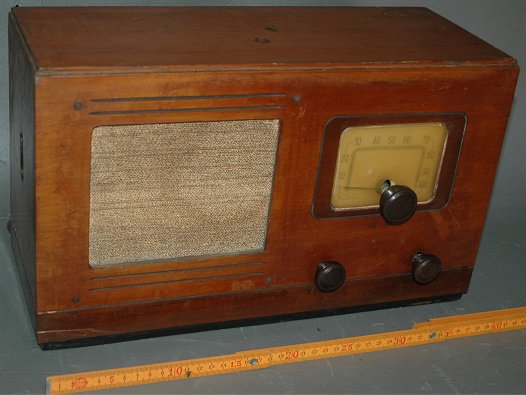
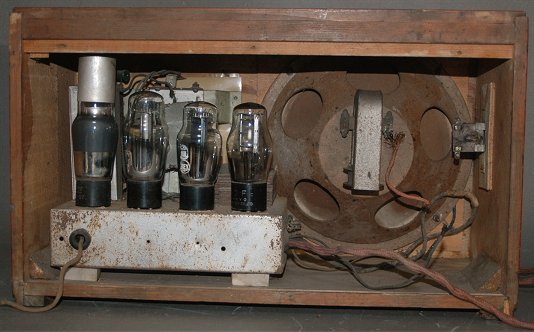
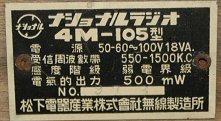
TRF Receivers from 1946 to 48
As a tool for democratization, GHQ needed prevailing of radio.
In 12/1945,Radio industry made the specifications of standard receiver.
Japanese standard radio was 4 tubes TRF radio.
It named “Kokumin-gata“ radio. “Kokumin” means “national”.
In the spring of 1946, many Kokumin-gata radio put on the market.
On the first standard, old-fashioned regenerative set (0-V-2) was
deleted.
Heater voltage changed from 2.5V into 6.3V. Circuit was 4 tubes TRF
(1-V-1) only.
However, the supply of new tubes was limited.
The standard
ended up with including old-fashioned circuit and tubes.
Many venture companies entered into radio industry after the war.
The big
businesses changed their business from munition industries into peacetime
industries.
They manufactured radios and other subsistence commodities to
keep their companies.
Kokumin-gata receiver was authorized as standard receiver by The Ministry
of Posts and Telecommunications.
Exemption of commodity tax for approved
Kokumin-gata receiver was recognized.
The approval needed to participate
in the shipment test by CEMA .
Then many approved Kokumin-gata receiver put on the market after the latter half of 1946.
However, short lived set until restarting of approval system existed.
We will introduce TRF and regenerative set except approved Kokumin-gata radio on our collection.
NOTICE:
Gothic is latest updates.
Japanese terms or company
names that is untranslatable are shown in spelled in Italics.
When not mentioned specially, all set are Super Heterodyne, all prices
are original retail price.
TRF and Regenerative Set (A.C.) (Except Approved Set)
National Model 4M-105 4 tubes Regenerative 1946? Matsushita Electric Ind. Co., Ltd. Wireless MFG. Dept.
Universal Model 4R-10 4 tubes TRF 1946 Ashikaga Tsushinki K.K.
Nanaola Model NH-4052 Kokumin-gata No.2 4 tubes TRF 1946 Nanao Radio Co.,Ltd.
Concertone Kokumin-gata No.6 4 tubes TRF 1947 ? Tone Musen K.K.
Akatsuki Model unknown 4 tubes Regenerative 1946 Akatsuki Musen K.K.
Toshiba Model ZS-1005C Kokumin-gata No.2-A 4 tubes TRF 1947 Tokyo Shibaura Electric Co., Ltd.
Futaba Kokumin-gata No.2 4 tubes TRF 1946 Futaba Electric MFG. Co., Ltd.
Futaba Hyojyun No.1 type C Model FH-5C 5 tubes TRF 1947 Futaba Electric MFG. Co., Ltd.
Futaba Hyojyun No.1Model FH-1E 5 tubes TRF 1947 Futaba Electric MFG. Co., Ltd.
Futaba Hyojyun No.1Model FH-5D 5 tubes TRF 1947? Futaba Electric MFG. Co., Ltd.
Tom Kokumin-gata No.4 4 tubes TRF 1947? Tokyo Musen Denki K.K.
NOBLE Kokumin-gata No.4 4 tubes TRF 1948 Teikoku Tsushin Kogyo Co., Ltd.
TAC Kokumin-gata 4 tubes Regenerative 1947 Tokyo Art Craft Co.
TAC Kokumin-gata No.4 4 tubes TRF 1948 Tokyo Art Craft Co.
Sun Light Model TTB-47 Kokumin-gata No.4-B 4 tubes TRF 1948 Hitachi Ltd.
Sun Light Kokumin-gata No.4 4 tubes TRF 1948 Hitachi Ltd.
General Kokumin-gata No.2 4 tubes TRF 1948? Yaou Radio Manufacturing Co.,
Jenic Model NB-41Kokumin-gata No.4 4 tubes TRF 1948 Nippon Denshi Kogyo K.K. JPY 3,168.40
Jenic Model NB-?? Kokumin-gata No.4 4 tubes TRF 1948 Nippon Denshi Kogyo K.K.
TOYOTA Model unknown 4 tubes TRF Marine? Radio 1948? Toyota Motors Co., Ltd. Kariya South
Factory
TOPIC Model unknown Kokumin-gata No.4 4 tubes TRF 1948? Topic Radio Laboratory
GOLD RADIO "New Trade" 4 tubes TRF 1948? Maehara Electric Co. Ltd.
Million Kokumin No.4-B 4 tubes TRF 1948 Iwasaki Tsushinki K.K.
TRF Radio (D.C.)
National Model unknown Battery Operated 4 tubes TRF 1946? Matsushita Electric Ind. Co., Wireless MFG. Dept.
TRF and Regenerative Radio (A.C.) (Except Approved Set)
National Model 4M-105 4 tubes Regenerative 1946? Matsushita Electric Ind. Co., Ltd. Wireless MFG. Dept.



TUBES: 57 56 12A 12F , Magnetic Speaker (Paper framed), Auto-transformer,
Matsushita reopened manufacturing of civilian apparatus in 1946.
This model was their early model after WWII.
Circuit was conventional 4 tubes regenerative (0-V-2).
Dial and other parts were diverted from war time standard set.
To reduce material, auto-transformer used.Chassis was insulated from enclosure
to avoid electric shock like transformer-less set.
Most of early Matsushita’s TRF set approved by NHK. Only this model 4M-105
did not approved.
Straight regenerative set sometimes caused interference to other radio by over regeneration.
GHQ prohibited manufacturing of regenerative set. This model was discontinued
in a short time.
Knobs were unoriginal.
(Collection No.11878)
Universal Model 4R-10 4 tubes TRF 1946 Ashikaga Tsushinki K.K.
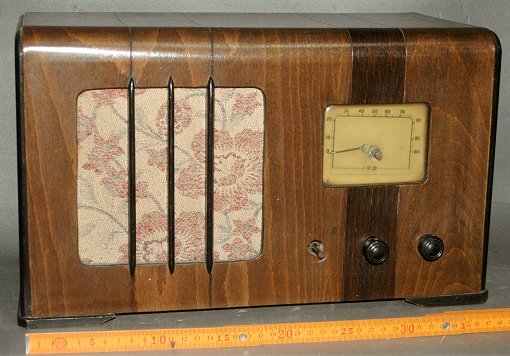
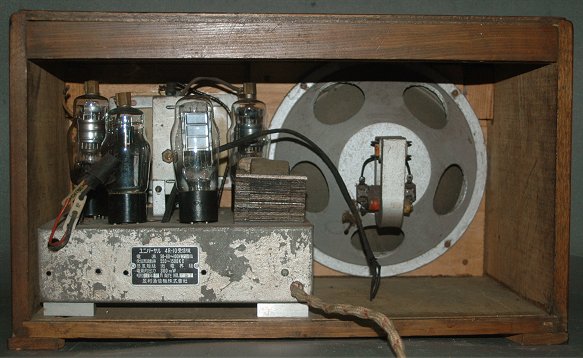
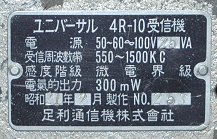
TUBES: MC-658-A - MC-658-A - UY-38A - KX-12F , Magnetic Speaker
This was small manufacturer’s TRF set that dated 02/1946.
It was very early products after end of the war.
The line-up of tubes was unusual.
MC-658-A was special tube for communication system licensed from Western Electric.
UY-38A was used for military equipment.
Heater voltage was changed from 2.5V to 6.3V after the war.
Small power tube suitable for magnetic speaker did not exist in Japanese
6.3V tubes. 6ZP1 did not released yet.
No information about manufacturer existed.
The manufacturer that produced military and communication probably equipment assembled own stocked material.
Rear cover was missing.
(Collection No.11742)
Futaba Kokumin-gata No.2 4 tubes TRF 1946 Futaba Electric MFG. Co., Ltd.
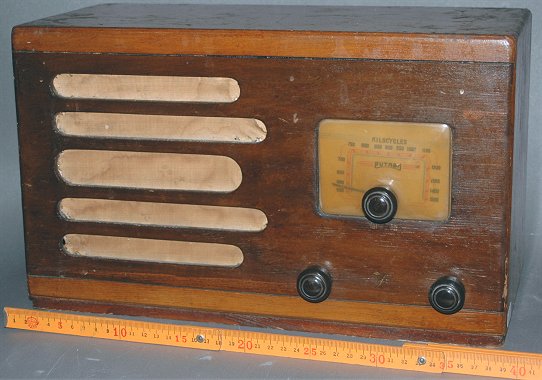
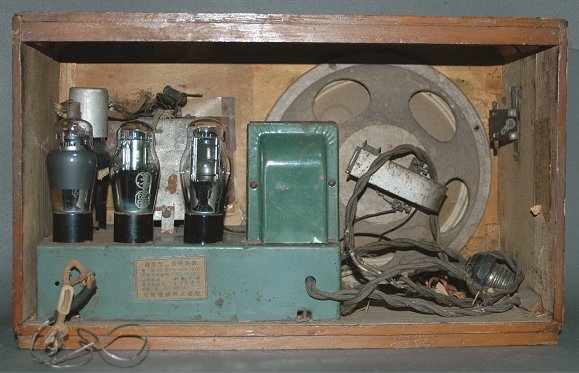
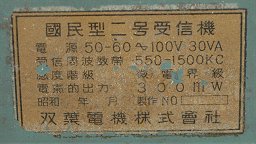
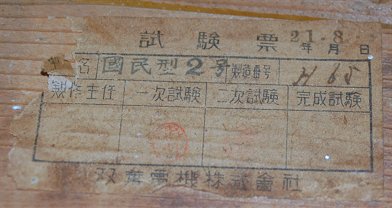
TUBES: 6D6-6C6-6ZP1-12F, Magnetic Speaker
Futaba Electric MFG. Co., Ltd. was one of leading companies in Osaka founded
in 1931.
This model was typical model of Kokumin-gata radio.
The design of cabinet and dial was similar to Housoukyoku-gata radio.
Futaba Electric got first approval in 12/1946 after the war.
This example manufactured in 08/1946.
Approval mark was not indicated.
(Collection No.11678)
Nanaola Model NH-4052 Kokumin-gata No.2 (1946 ) Nanao Radio Co.,Ltd.
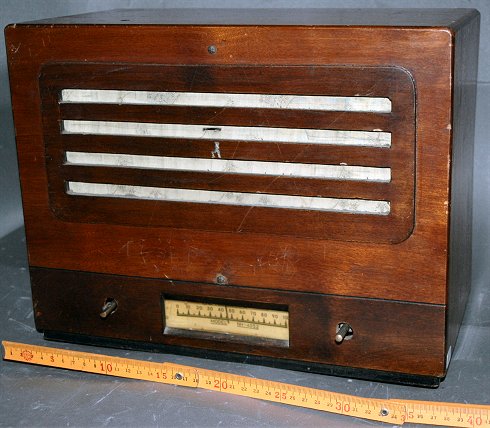
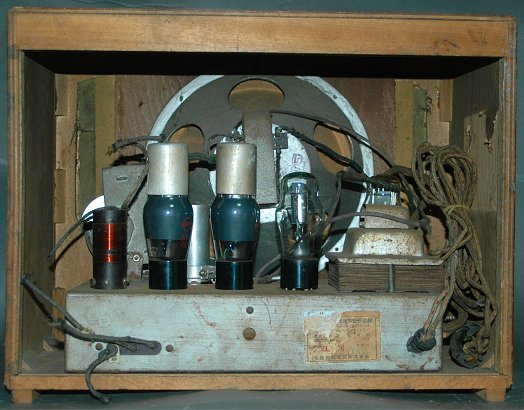
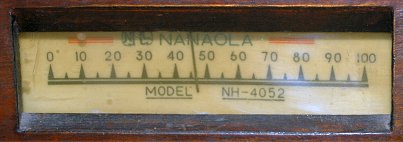
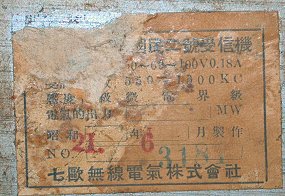
TUBES: 6D6-6C6-6ZP1-12F, Magnetic Speaker
Nanao Radio was one of leading companies from pre war.
This model was early model after the war before restarting the approval system.
Most of Kokumin-gata radio placed dial and speaker side by side.
This style was continued from late 1930’s.
This model had modernized cabinet and slide rule dial.
Nanao’s later model had typical design.
Knobs were missing.
(Collection No.11650)
Concertone Kokumin-gata No.6 (1947 ?) Tone Musen K.K.
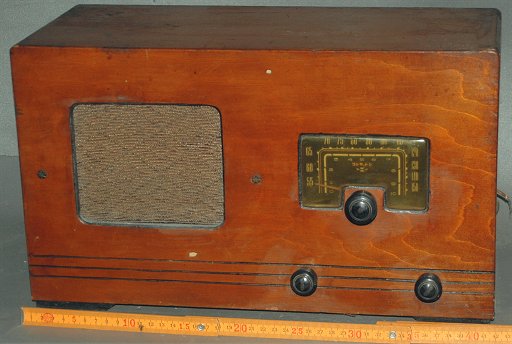
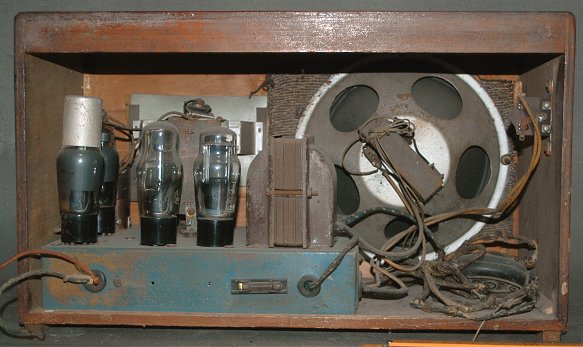
TUBES: 58-57-47B-12F, Magnetic Speaker
Tone Musen was medium standing manufacturer at eastern area.
No.6 set used old 2.5V tubes. However, the name of 6.3V tubes indicated on the chassis.
No nameplate or labels inside.
(Collection No.11425)
Akatsuki Model unknown Regenerative 4 tubes (1946 Akatsuki Musen K.K.)
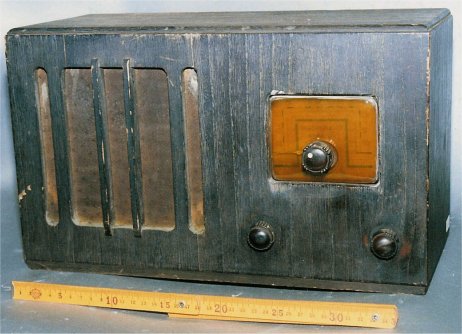
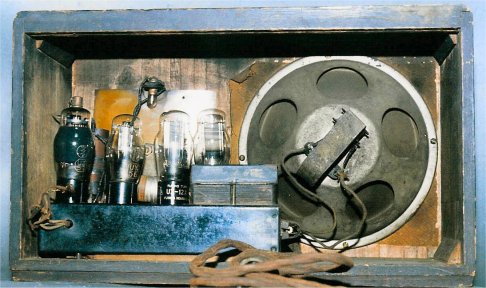
TUBES: 57-56-12A-12F, Magnetic Speaker
Akatsuki Musen was founded as subsidiary of Seiki Kogaku Kogyo (Canon Camera
Co., from 1947) after the war to manufacture radio set.
They tried to change their business into peacetime industries.
This model was 4 tubes regenerative set dated in 07/1946 and no approval.
Construction and finish was very poor.
The production of regenerative set was prohibited by GHQ to avoid interference
in 1948.
GHQ made Canon Camera closed Akatsuki Musen in 04/1949.
(Collection No.11549)
Toshiba Model ZS-1005C Kokumin-gata No.2-A (1947 ) Tokyo Shibaura Electric Co., Ltd.
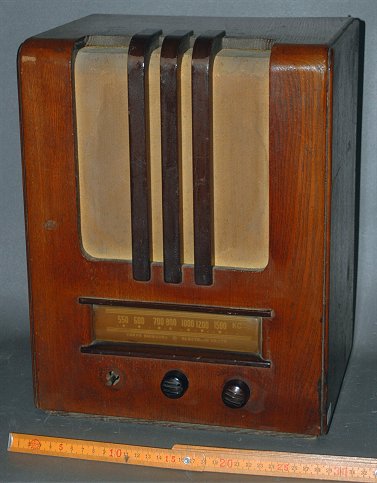
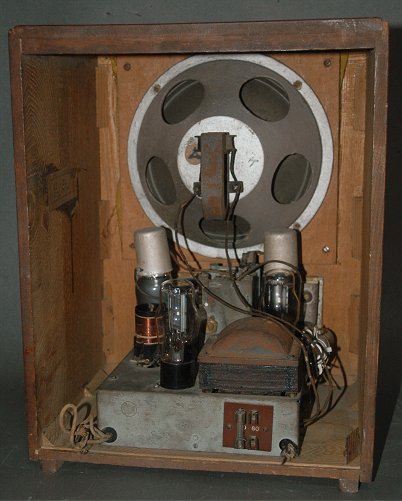
(Collection No.11712)
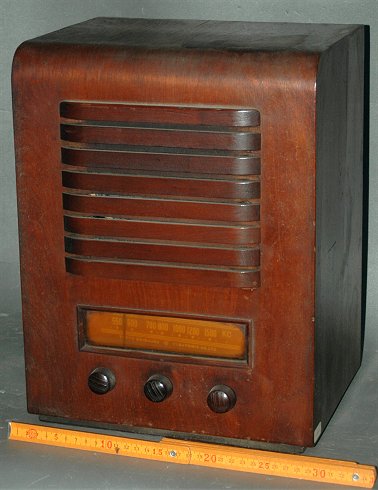
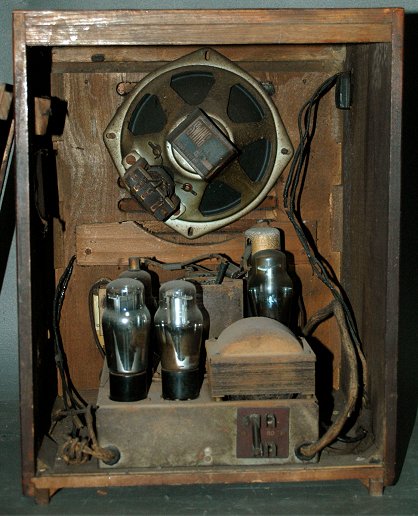
(Collection No.11405)
TUBES: 6C6-6C6-6ZP1-12F, Magnetic Speaker
Toshiba came back to production of radio set after the war.
A few Toshiba
radio in early 1940’s was OEM supplied products.
After the war, they produced
radio set at own factory.
Model ZS-1005C was one of the Toshiba’s first products. Tombstone style
was rare at that time.
Circuit was typical TRF Kokumin-gata set.
2 variations of cabinet existed. Chassis was equaled.
Collection No.11712 kept original condition.
About No.11405, UY-76 was added as first amplifier and speaker replaced into permanent dynamic type.
(Collection No.11405)
Futaba Hyojyun No.1Model FH-1E (03/1947) Futaba Electric MFG. Co., Ltd.
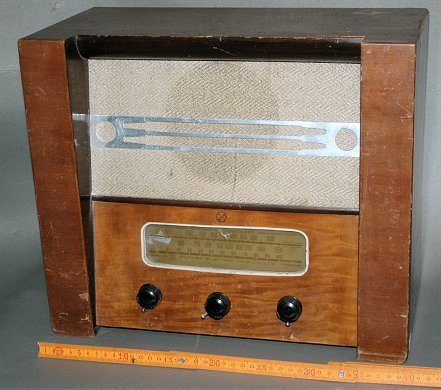
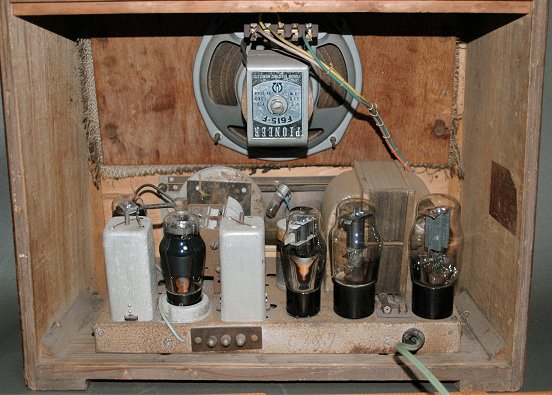
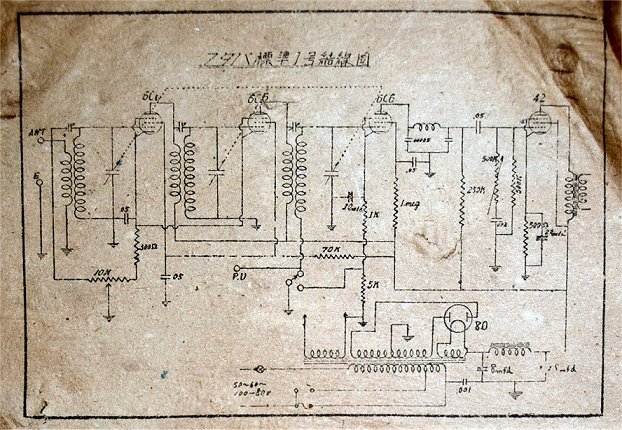
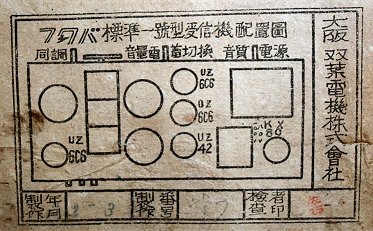
TUBES: 6C6-6C6-6C6-42-80, TRF, 6.5" Electro-dynamic Speaker (Pioneer)
This 5 tubes set was not super heterodyne, this was 5 tubes TRF (2-V-1) set.
5 tubes 2-V-1 TRF was very popular as hi-end radio until end of the war.
After the war, super heterodyne became main stream.
Factory made 2-V-1 set was very rare.
Japanese term "Hyojyun" means "standard". But this
set was not standardized set.
European ? styled cabinet and construction was old fashioned.
This set used 6C6 instead of 6D6. Variable mu tube like 6D6 was difficult to manufacture and supply was limited.
Model FH-1E was changed into Model FH-5C.
This example was modified into super heterodyne.
Knobs, speaker, power transformer was unoriginal.
(Collection No.11658)
Futaba Hyojyun No.1 type C Model FH-5C (06/1947 Futaba Electric MFG. Co., Ltd.)
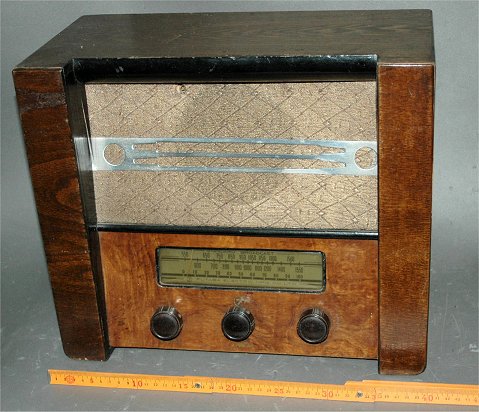
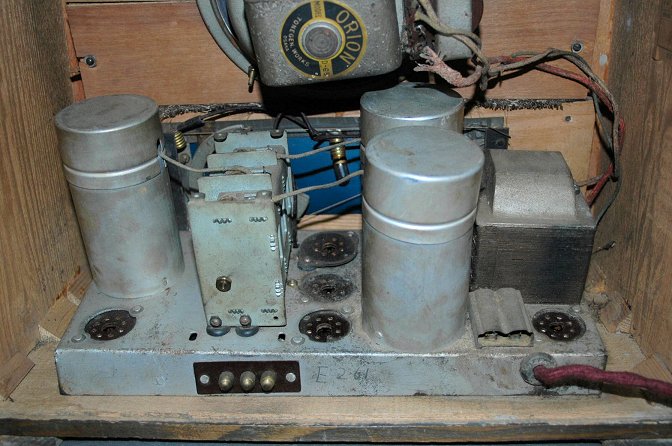
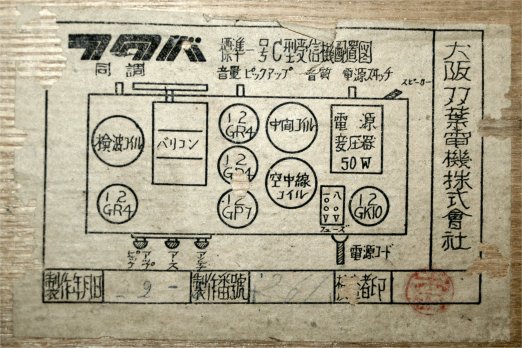
TUBES: 12GR4-12GR4-12GR4-12GP7-12GK10, TRF, 6.5" Electro-dynamic Speaker
(Orion)
This 5 tubes set was not super heterodyne, this was 5 tubes TRF (2-V-1) set.
5 tubes 2-V-1 TRF was very popular as hi-end radio until end of the war.
After the war, super heterodyne became main stream.
Factory made 2-V-1 set was very rare.
Japanese term "Hyojyun" means "standard". But this set was not standardized set.
This model used JRC “12G” series MG tubes.
These tubes licensed under Telefunken Germany used octal base but connection was German style. Heater voltage was 12.6V
No compatibility kept with American metal or GT tube.
“12G” series was not accepted from Japanese market.
Except early JRC’ s set, radio set used 12G tubes were very rare.
Design of cabinet and construction of chassis were old.
This model was revised model of FH-1E (6.3V ST tubes were used).
All tubes were missig.
(Collection No.11601)
Futaba Hyojyun No.1 Model FH-5D 1947? Futaba Electric MFG. Co., Ltd.
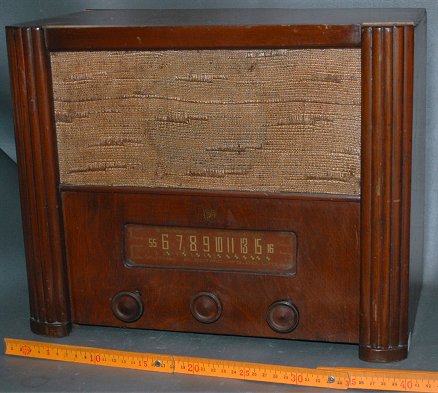
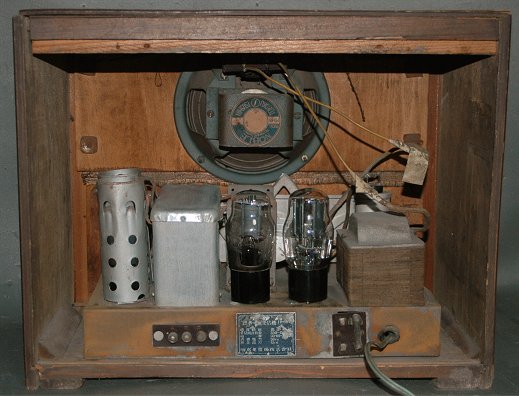
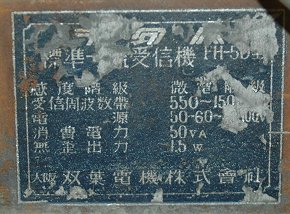
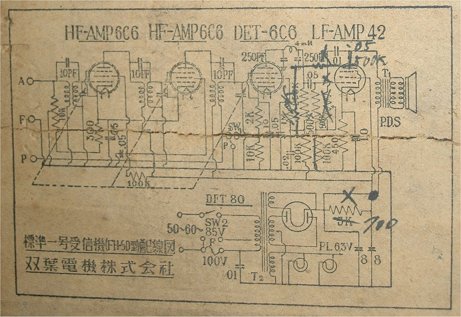
TUBES: 6C6-6C6-6C6-42-80, TRF, 6.5" Permanent Dynamic Speaker (NOBLE
Model PD-65
This 5 tubes set was not super heterodyne, this was 5 tubes TRF (2-V-1) set.
5 tubes 2-V-1 TRF was very popular as hi-end radio until end of the war.
After the war, super heterodyne became main stream.
Factory made 2-V-1 set was very rare.
Japanese term "Hyojyun" means "standard". But this set was not standardized set.
The line up of pre war 2-V-1 set was 58-58-57-2A5-80.
This set used 6C6 instead of 6D6. Variable mu tube like 6D6 was difficult to manufacture and supply was limited.
Variation model which used different chassis existed.
(Collection No.11782)
Tom Kokumin-gata No.4 (1947? ) Tokyo Musen Denki K.K.
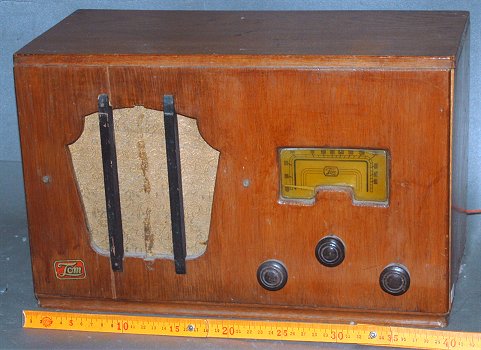
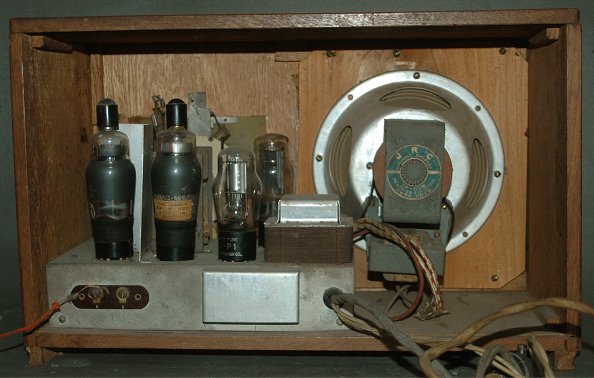
TUBES: 6D6-6C6-42-12F, Electro-dynamic Speaker (JRC Model SP-65, 6.5")
Tom was well known as a manufacturer of P.A. system. This was middle class
TRF set with dynamic speaker.
Parts and materials were probably their stock s for military equipment.
This example was lost the enter of speaker grill.
(Collection No.11404)
NOBLE Kokumin-gata No.4 1948 Teikoku Tsushin Kogyo Co., Ltd. JPY 3,000 (このセットの小売価格)
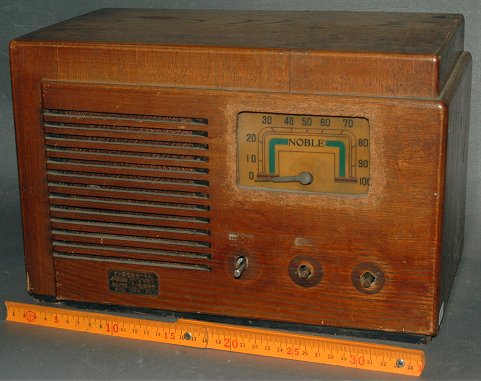
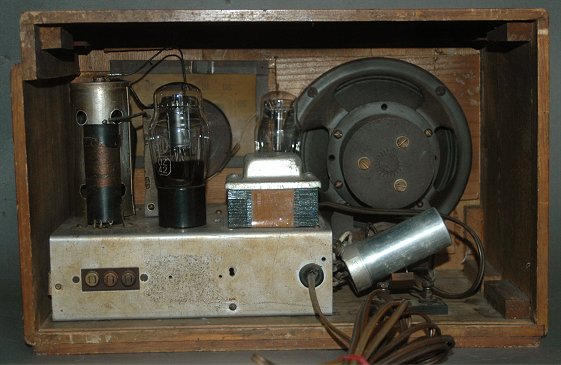
TUBES: 6D6-6C6-42-12F, Permanent Dynamic Speaker (NOBLE)
The Teikoku Tsushin Kogyo Ltd. established in 1944. And they continued
their business as electronic parts manufacturer now. Brand was “Noble”
This model was early model of their radio product.
Kokumin-gata No.4 was hgh grade TRF set with dynamic speaker.
They manufactured permanent dynamic speaker.
Knobs and escutcheon of dial were missing.
Power transformer was replaced in 1960’s.
(Collection No.11762)
TAC Kokumin-gata 1947 Tokyo Art Craft Co.
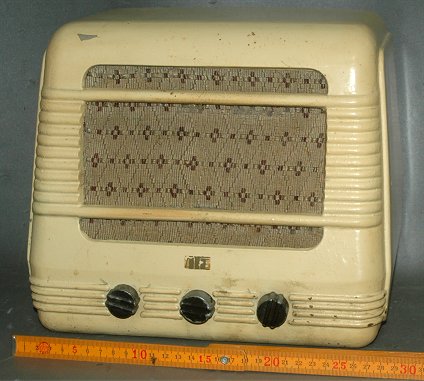
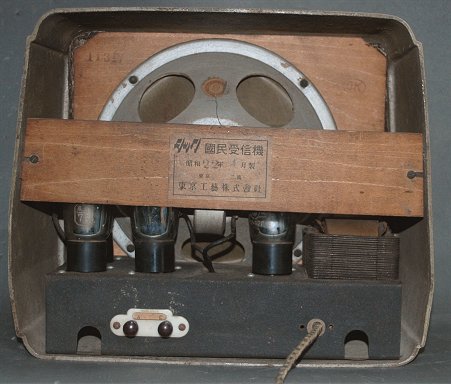
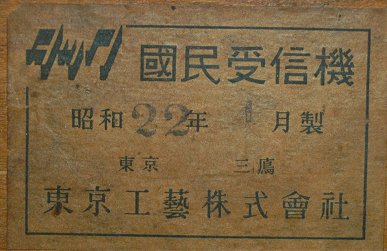

TUBES: 6D6-76-76-12F, Magnetic Speaker (Pioneer, Paper Framed)
TAC (Tokyo Art Craft) was new comer of radio industry after the war. This
model was their first model.
Circuit was ordinary regenerative set. But construction was very unique.
They molded Aluminum into stream lined cabinet.
Aluminum was abundant by surplus of scrapped airplane.
The finish of aluminum cabinet was very good.
The prototype of this model stored in The NHK Broadcasting Museum.
Appeared on The Radio Amateur 06/1947 (Advertisement)
(Collection No.11763)
TAC Kokumin-gata No.4 1948 Tokyo Art Craft Co.
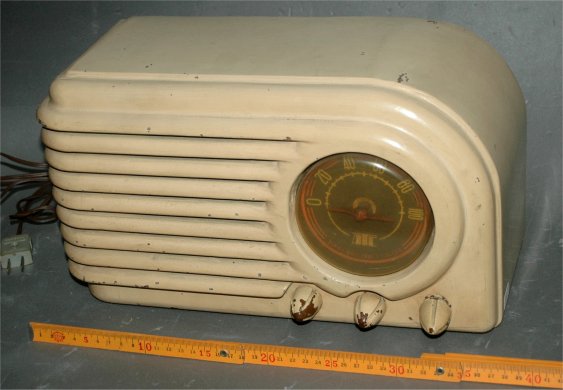
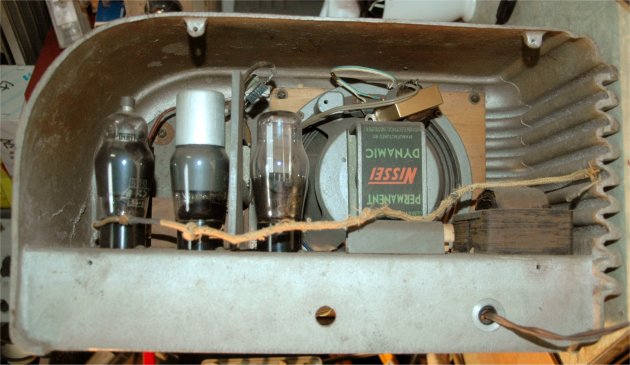

TUBES: 6D6-6C6-6ZP1-12F, Permanent Dynamic Speaker (Nissei)
TAC (Tokyo Art Craft) was new comer of radio industry after the war.
Circuit was ordinary TRF set. But construction was very unique.
They molded Aluminum into stream lined cabinet.
Aluminum was abundant by surplus of scrapped airplane.
Chassis was integrated in the cabinet and molded at the same time.
No one knew such construction of tube radio.
They were outsiders of radio industry. They could create unique construction.
In 1948, The prototype of new super heterodyne set using same cabinet appeared on the magazine. However new model did not put on the market.
TAC probably bankrupted.
The concept of the company was not acceptable in those days.
They founded too early. If they founded after 1950’s, they grew up to be good designer’s group.
Appeared on The Denpa Nippon Vol.45 No.1,2 published by Nippon Denpa Kyokai
(Collection No.11616)
Sun Light Model TTB-47 Kokumin-gata No.4-B (1948 Hitachi Ltd.)
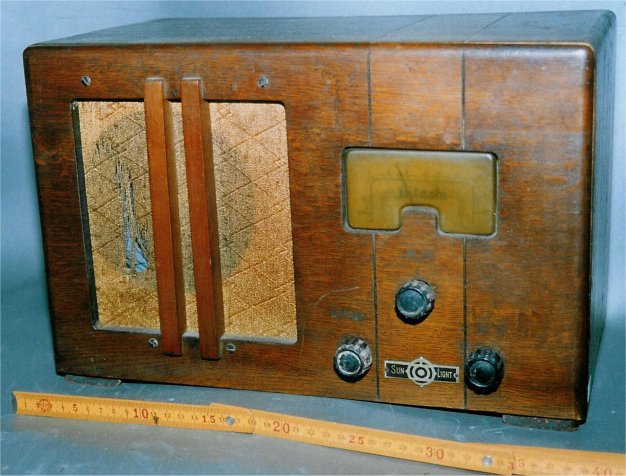
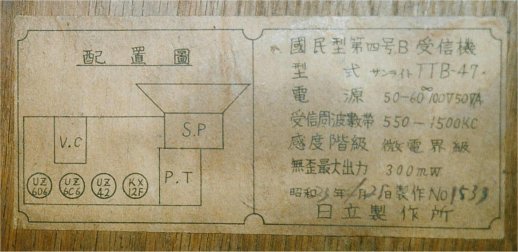
TUBES: 6D6-6C6-42-12F, Permanent Dynamic Speaker
Hitachi Ltd. started production of radio to reconverted from war production.
They named their TRF set “Sun Light” and named super heterodyne set “Moon Light”.
All Sun Light radio were middle class sets with dynamic speaker.
Cabinet was very strong. Schematic diagram is as follows.
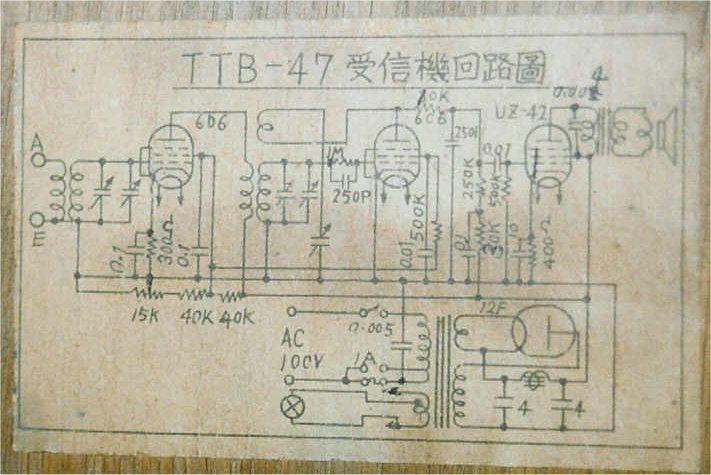
This example was modified into super heterodyne.
(Collection No.11559)
Sun Light Kokumin-gata No.4 1948 Hitachi Ltd.
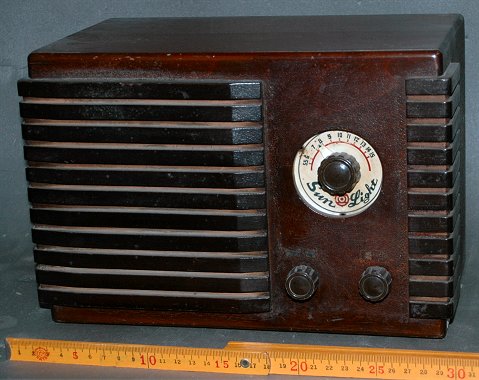
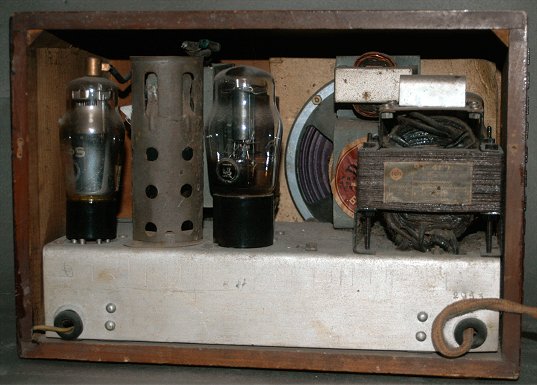
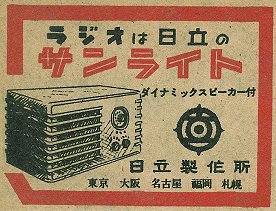
The illustration of this advertisement was different from real set.(From
Denpa Kagaku 07/1948)
TUBES: 6D6S-6C6-42-12F, Permanent Dynamic Speaker (Hitachi, 5")
Hitachi’s early small sized TRF set with dynamic speaker.
The UZ-6D6S was original revised tube by Hitachi.
But it was only selected tube from poor products.
Quality and construction of this set was good.
However, Hitachi did not have enough sales stuff.
Sales result of Hitachi radio was not good.
Most of Hitachi radio supplied to their members instead of salary.
(Collection No.11235)
General Kokumin-gata No.2 (1948?Yaou Radio Manufacturing Co.,)
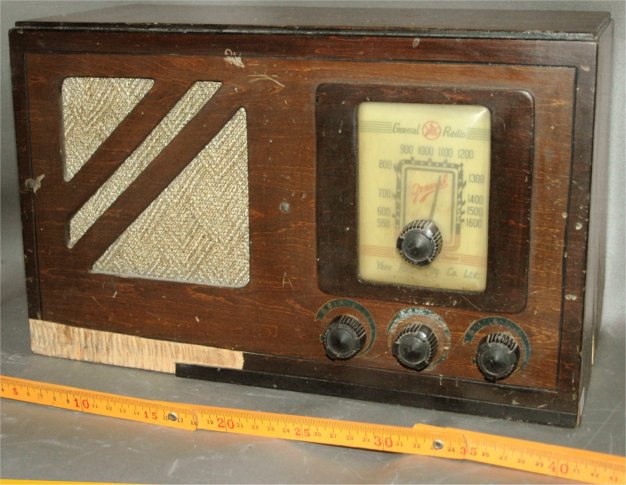
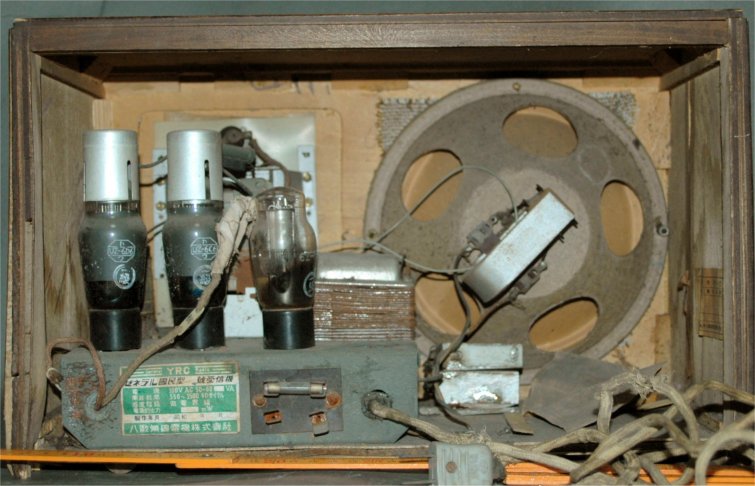
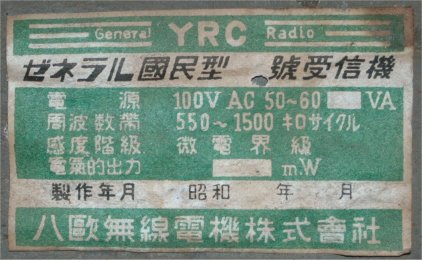
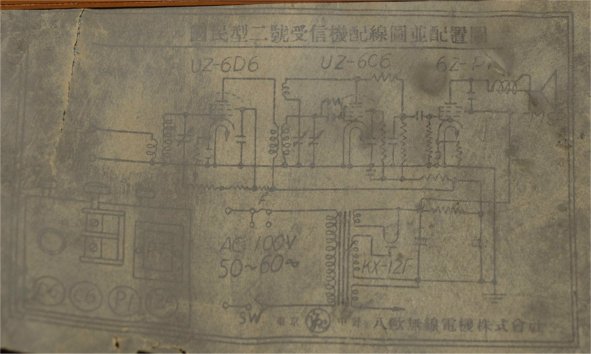
TUBES: 6D6-6C6-6ZP1-12F, Magnetic Speaker
Yaou’s typical Kokumin-gata radio.
Rectifier tube was missing. The condition of cabinet was fear.
(Collection No.11622)
Jenic Model NB-41 Kokumin-gata No.4 (1948) Nippon Denshi Kogyo K.K. JPY 3,168.40
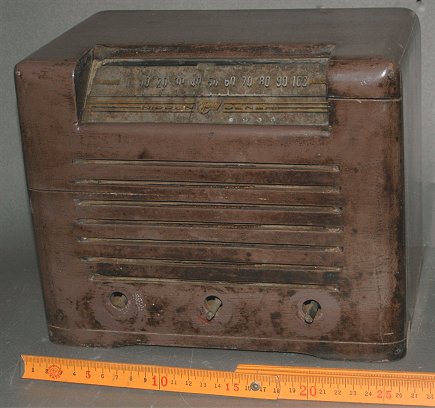
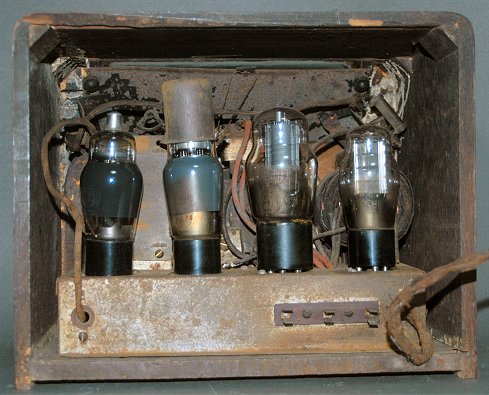
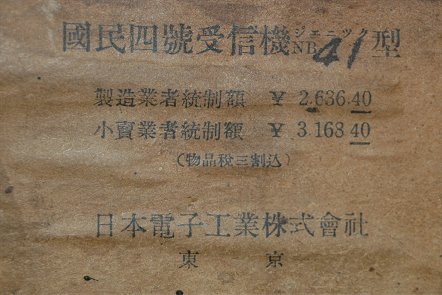
TUBES: 6D6-6C6-6ZP1-12F, ELectro-dynamic Speaker (Jenic Model D-110, 5")
Small manufacturer’s TRF set.
RCA like designed cabinet was made by painted wood.
Size was smaller than typical Japanese set.
Coils were installed inside of chassis.
This construction caused some trouble.
Knobs and back cover were missing.
(Collection No.11699)
Jenic Model NB-?? Kokumin-gata No.4 (1948) Nippon Denshi Kogyo K.K.
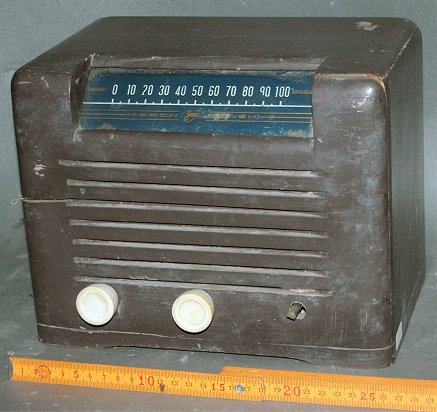
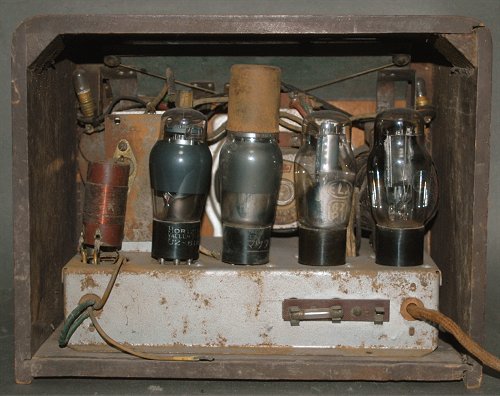
TUBES: 6D6-6C6-6ZP1-12F, ELectro-dynamic Speaker (Jenic Model D-110, 5")
This model was revised model of NB-41.
The construction of chassis was renovated.
Antenna coil was installed on the top of chassis.
Cabinet was similar to Model NB-41. However, details were different.
(Collection No.11439)
TOYOTA Marine Radio? Model unknown TRF 4 tubes (1948? ) Toyota Motors Co., Ltd. Kariya South Factory
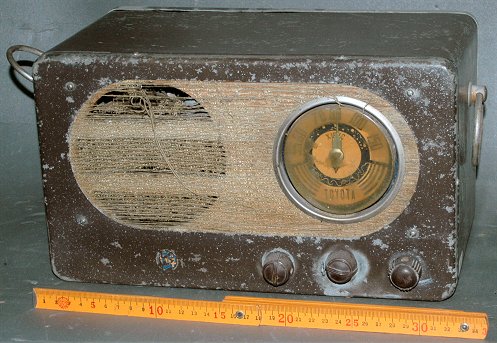
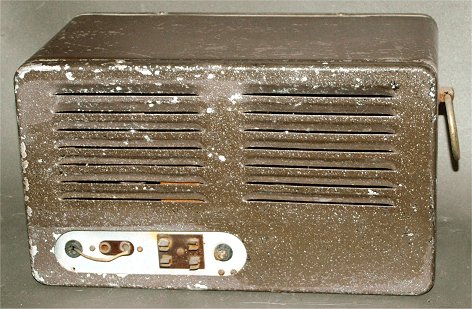
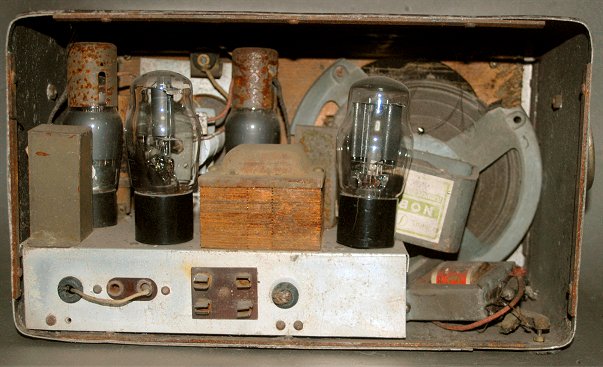
TUBES: 6D6-6C6-42-80, Permanent Dynamic Speaker (NOBLE, 6.5")
Toyota Motor Co., was prohibited manufacturing of automobile by GHQ after
WWII.
To continue own business, they manufactured radio in the factory manufactured electric parts for automobile from 1946.
This model probably made for small fishing boat. Most of Japanese small
fishing boat did not have any radio. Short wave radio was very expensive.
Installing a BC band radio was recommended to receive weather news. The
correct details of this model were unknown.
At 10/1949, The production of automobile was permitted completely by GHQ. Toyota Motor continued production of radio until 1951. Toyota withdrew from production of radio by reconstruction of automobile industry.
This factory became independent of Toyota Motor Co., Ltd. This factory became Denso Ltd now.
Speaker was broken.
(Collection No.11340)
TOPIC Model unknown Kokumin-gata No.4 1948? Topic Radio Laboratory
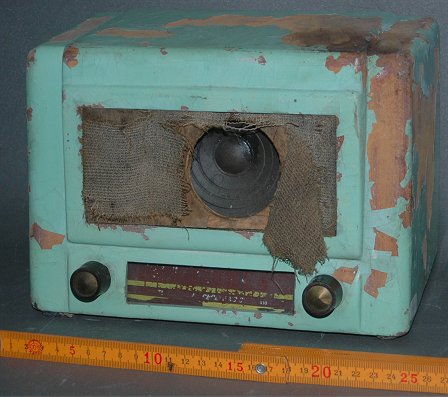
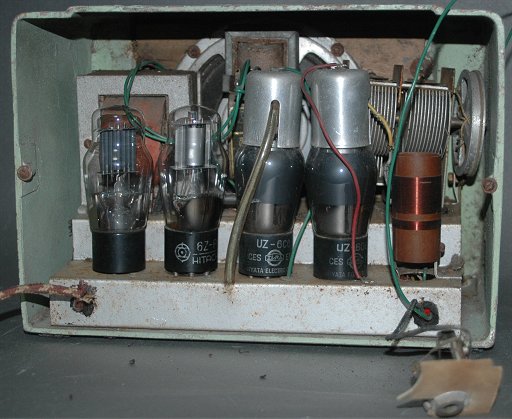
TUBES: 6D6-6C6-6ZP1-12F, Permanent Dynamic Speaker (JTO-ON Model SD-1,
5")
Small manufacturer’s TRF small set.
Cabinet was aluminum molded.
To install large size tubes into small cabinet, “stepped” chassis used.
Back cover broken. The condition of cabinet was fear.
(Collection No.11702)
GOLD RADIO "New Trade" 1948? Maehara Electric Co. Ltd.
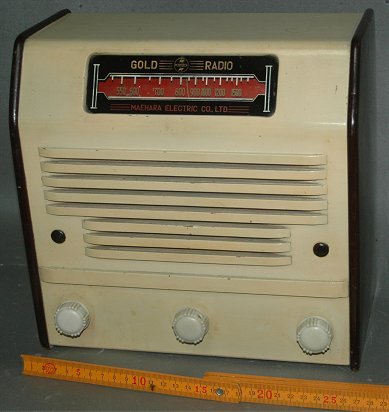
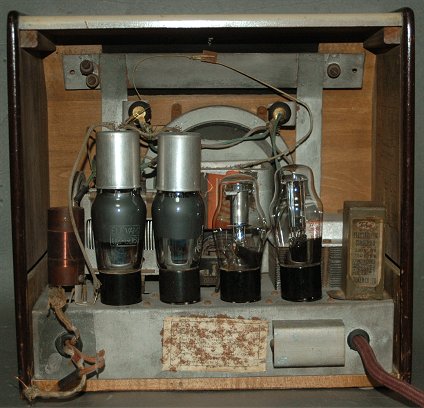
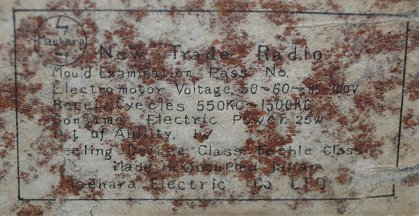
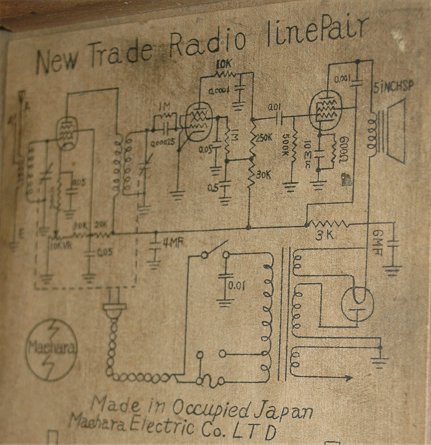
TUBES: 6D6-6C6-6ZP1-12F, Permanent Dynamic Speaker (Nissei, 5")
Small manufacturer’s TRF small set with painted wooden cabinet.
The labels and nameplate were indicated in English.
However, They probably did not have enough knowledge of technical terms.
Translation was not correct. It became incomprehensive English.
(Collection No.11828)
Million Kokumin No.4-B 1948 Iwasaki Tsushinki K.K.

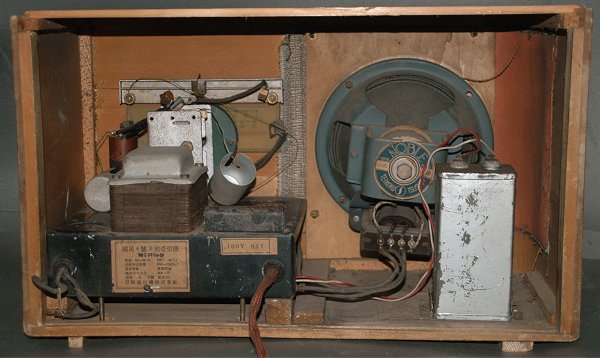
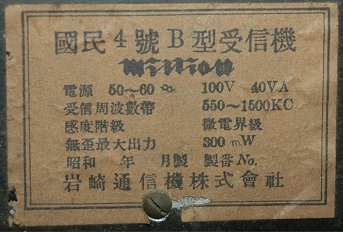
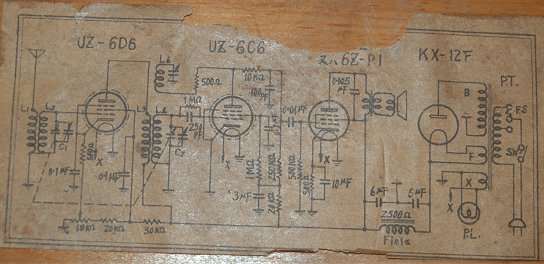
TUBES: 6D6 6C6 42 or 6Z-P1 12F , 6.5" Electro-dynamic Speaker (NOBLE
Model FD-65)
Iwasaki Tsushinki that was leading company of communication equipment manufactured
home use radio after the war.
This model was high grade TRF set equipped electro-dynamic speaker.
This model was changed into Model KR-4 equipped permanent dynamic speaker.
TUBES were missing and cabinet was broken.
(Collection No.11860)
TRF Radio (D.C.)
National Model unknown Battery Operated 4 tubes TRF 1946? Matsushita Electric Ind. Co., Wireless MFG. Dept.
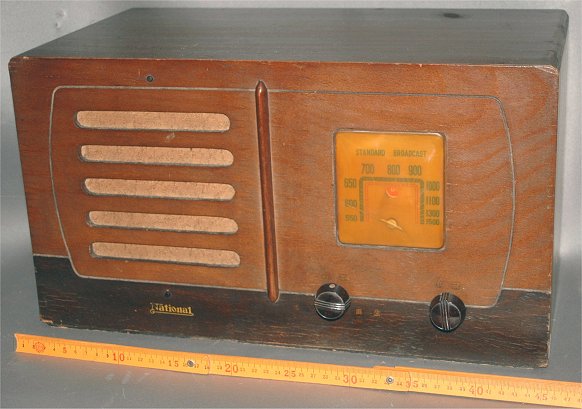
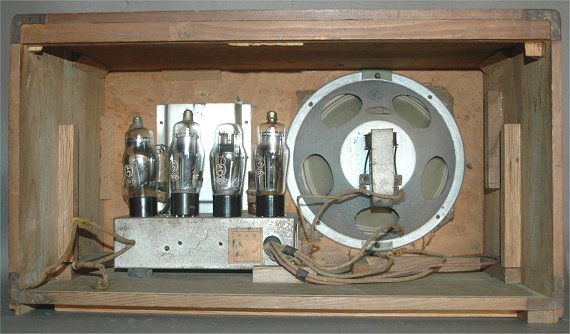
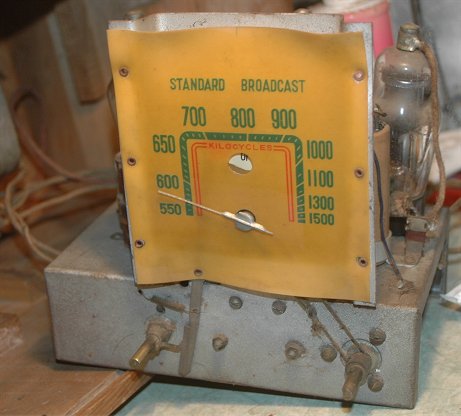
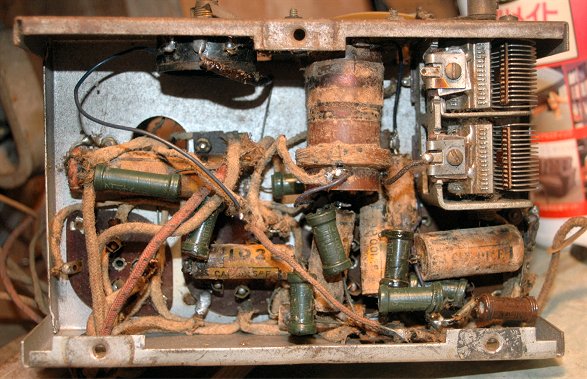
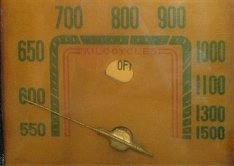
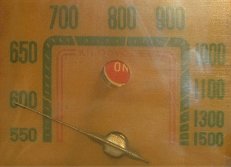
The linkage fitted to power switch moved indicator on the dial. It could
be omit pilot lamp.
TUBES: 167-167-167-169, Magnetic Speaker (National Model PM-200, Paper
Framed), W460, D250(mm)
Matsushita’s battery operated TRF set.
Cabinet was larger than conventional AC set to install batteries.
Tubes were Japanese original low series for battery set.
Battery operated set used for emergency use or education in country area.
Pre war battery operated table top set was rare.
Chassis was similar to their AC set model 4M-103.
After the war, supply of electric power was unstable.
Listeners needed emergency crystal or battery operated radio.
At war time, Matsushita manufactured battery operated super heterodyne set for emergency use.
This model was probably new emergency battery operated radio.
(Collection No.11666)